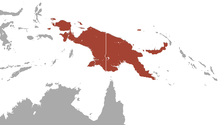Flat spiked nose bag
| Flat spiked nose bag | ||||||||||||
|---|---|---|---|---|---|---|---|---|---|---|---|---|
| Systematics | ||||||||||||
|
||||||||||||
| Scientific name | ||||||||||||
| Echymipera kalubu | ||||||||||||
| ( Fischer , 1829) |
The flat spiked-nosed bucket ( Echymipera kalubu ) is a species of marsupial that occurs with four subspecies in New Guinea and some surrounding islands.
Subspecies and distribution
- Echymipera kalubu kalubu , the nominate form of the species, occurs in most of New Guinea and on the islands of Misool , Salawati , Waigeo , on Yapen , as well as on Bagabag , Blup Blup , Kadovar , Karkar , Koil and Vokeo .
- Echymipera kalubu cockerelli lives on different islands of the Bismarck Archipelago ( New Britain , Manus and some nearby islands).
- Echymipera kalubu oriomo occurs in the south of New Guinea in the catchment area of the Fly River .
- Echymipera kalubu philipi lives on the islands of Biak , Supiori and Owi in the Cenderawasih Bay .
features
The flat-spiked nasal bucket reaches a head body length of 22.5 to 38 cm, has a 6.3 to 9.8 cm long tail and weighs 0.4 to 1.8 kg, whereby the subspecies are of different sizes. E. k. oriomo and E. k. philipi are relatively small, E. k. kalubu can be up to 50% larger than the two subspecies. There is also strong sexual dimorphism, and males can weigh twice as much as females. The back fur is red-brown, with black hair lying between the reddish hairs. Belly, throat and cheeks are light. Some specimens show a dark eye stripe, in others the entire top of the head is dark. With the nominate form and E. k. philipi occur melanistic , completely dark specimens. In contrast to the red sting-nosed pouch ( Echymipera rufescens ) and the Clara sting-nosed pouch ( Echymipera clara ), the soles of the hind feet are not dark.
Habitat and way of life
Flat-spiked-nosed bucks live in all habitats from sea level to heights of about 2000 meters. They prefer secondary forests, gardens and grasslands. Primary forests are mainly populated when they have already been disturbed by humans. Flat-spiked noses were also found in swamps with sago palms , as well as in banana and coffee plantations. The animals are nocturnal and spend the day in nests under tree roots, in large tufts of grass or in self-dug earthworks with two entrances that can be up to four meters below the ground. The animals begin their activity period between 6 p.m. and 8 p.m. and are most active between 8 p.m. and 2 a.m. Another activity period is between 4 a.m. and 6 a.m. In between, the animals sometimes return to the nest.
The flat-spiked nasal sac is omnivorous, but fruits are more important in its diet than other nasal sacs. Often fruits are eaten by screw trees , bananas and figs. Animal nutrition primarily includes invertebrates that live in or on the ground, such as worms, snails and insect larvae that live in rotting wood.
Reproduction
The flat-spiked nasal bucket is very fertile and reproduces throughout the year. 56 of 85 females caught in a study in Chimbu Province had young in their pouches, compared to 66 to 71% of the females in comparable studies. The interval between two births is around 120 days. One to six young animals are born per litter, in most cases three. The females have six teats in the bag. They reach sexual maturity shortly after they leave their mother, weighing only 380 g. The testes of the males have the size of the fully grown specimens with a weight of 300 g.
Danger
The IUCN lists the flat-faced nasal bag as Least Concern. The range is large, the animals are quite numerous in some areas and the flat-spiked nasal pusher is the most common type of nosepiped in New Guinea.
Individual evidence
- ↑ a b c d e Christopher Dickman: Family Peramelidae (Bandicoots and Echymiperas). in Don E. Wilson , Russell A. Mittermeier : Handbook of the Mammals of the World - Volume 5. Monotremes and Marsupials. Lynx Editions, 2015, ISBN 978-84-96553-99-6 , pages 395-396.
- ↑ Echymipera kalubu in the Red List of Threatened Species of the IUCN 2016. Posted by: Leary, T., Wright, D., Hamilton, S., Singadan, R., Menzies, J., Bonaccorso, F., Helgen, K. , Seri, L., Aplin, K., Dickman, C. & Salas, L., 2016. Retrieved August 27, 2018.
